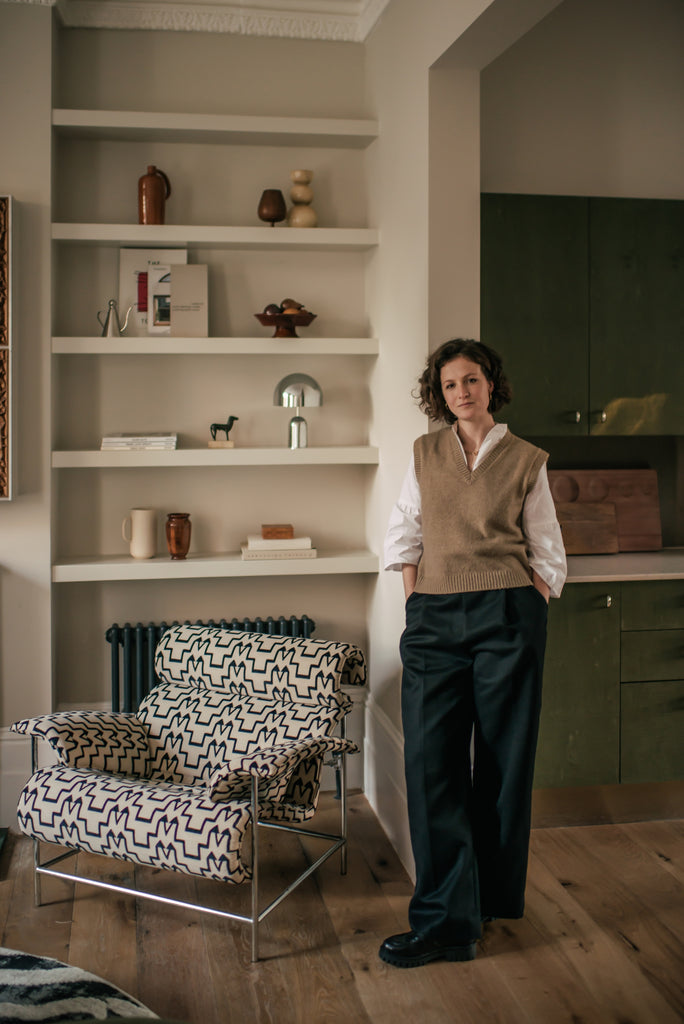In a world where haste often dictates our actions and decisions, the call for a slower, more deliberate approach now resonates across most industries. Just as the slow fashion movement has gained momentum, prompting a shift towards sustainable and seasonless apparel, the interior design realm finds itself to be part of a similar reckoning.
Tabitha Isobel, a seasoned interior designer who has recently ventured into the freelance world, offers her insightful reflections on the pressing need for deceleration within interior design. Drawing from her firsthand experiences in prominent design studios, Tabitha sheds light on the pervasive culture of haste.

Tabitha at a recently completed project in London
‘Slow Fashion’ is quickly becoming a well-known term, but what about other industries where things move too quickly in a desperate race to keep up with demand?
I believe the Interior Design world needs to slow down, too.
Having worked for some well-known design studios, I know all too well the pressure put on studios to produce and deliver in unrealistic deadlines. For some reason, we always say “Yeah sure, we can do that, no problem!”. Takeaway pizza and a cheeky beer have got me through many late nights in the studio - a true low point had me working on drawings in the car on the way to Cornwall one Christmas Eve.

Tabitha considers the site and the surrounding environment within all her work
Why the mad rush? There's always a fallout. It results in using materials that have shorter lead times, express deliveries from across the globe, mass produced furniture and trying to find the quickest (and not the best!) solutions. The result is a compromised design - as well as an overworked design team who who have nothing left to give at the opening party!
Although it can be tricky, designers need to be braver at clearly explaining to clients how long projects will take and why. From experience, once you gain a client's trust and understanding, they tend to be able to adjust to timescale changes much more readily.
Time is precious, and especially when it comes to Interior Design, it should be spent listening to your client, working on the best design solution possible, investigating sustainable materials, producing mock ups, searching for made to order furniture and hunting for vintage and antique pieces.
I love to combine vintage and antique furniture with new contemporary pieces. For me, it is a balance; a room full of vintage furniture can feel heavy and stuck in the past, whereas a room full of new pieces can lack character and charm. Finding the balance between the two is something I relish.
However, the trade off is that it takes time. Hunting for the perfect vintage 1970s coffee table can take days - weeks, even! Finding the perfect dining chairs from a sustainable supplier, with local manufacturing whilst factoring in made to order lead times could take upwards of 20 weeks. All that being said, it's always worth it to receive an item of fantastic quality with a timeless aesthetic.

A unique vintage piece sourced by Tabitha
Searching for sustainable materials also takes time. It's heartening to notice that there is an increasing demand for suppliers to produce responsibly made materials. I have recently come across bricks made from construction waste, linens and cottons created from excess materials from fashion houses, as well as VOC free and air purifying paint. These are just a few examples of the amazing materials now available. Again - it just takes that bit longer to do the research.
Another great way to be more sustainable is to use locally produced and sourced materials and furniture. For example, I have recently been specifying London Plane Timber for joinery within my London based projects, as this is the most common tree in the City. It is actually possible to source locally felled and found trees!
Like fashion, ‘trends’ are a real problem when it comes to trying to be ‘slower’. There are interior design trends which fall out of fashion before they have even been installed. Trends are hard to ignore and are bound to subconsciously influence design.
I follow some key principles to avoid falling for trends and creating unique work. I always create a concept, which is a narrative for the design of the space. To develop this I consider three areas:
1. The site itself,
2. The surrounding environment,
3. The client and their character.
If the design is inspired by these three principles it will be rooted, unique, and stand the test of time.


